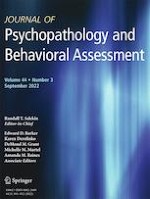16-03-2022
The Longitudinal Relationships between Family Functioning and Children’s Conduct Problems: The Moderating Role of Attentional Control Indexed by Intraindividual Response Time Variability
Gepubliceerd in: Journal of Psychopathology and Behavioral Assessment | Uitgave 3/2022
Log in om toegang te krijgenAbstract
Previous studies have examined the associations among the family environment, children’s attentional control indexed by intraindividual reaction time variability (IIRTV), and externalizing problems, and they have mainly focused on between-child comparisons. However, few studies have explored within-child associations among the family environment, IIRTV, and children’s externalizing problems, especially for conduct problems. The present study examined how children’s attentional control indexed by IIRTV and family functioning jointly predict Chinese children’s conduct problems from ages 6 to 9 years old at the within- and between-child levels.Two hundred thirty-six elementary school children and their parents participated in this longitudinal study, and data were collected when the children were in grade 1, grade 2, and grade 3. Elementary school children completed the go/no-go task to assess their IIRTV. Children’s parents completed the Chinese versions of the Family Adaptability and Cohesion Scale (FACES II-CV) and the Strengths and Difficulties Questionnaire (SDQ-CV) to assess family functioning and conduct problems, respectively.Multilevel models indicated that within-child changes in conduct problems were negatively correlated with within-child changes in family functioning. Moreover, both IIRTV and its interaction with family functioning significantly predicted individual differences in the development of conduct problems. Poor family functioning and attentional control indexed by greater IIRTV are stronger predictors of conduct problems, while better attentional control indexed by lower IIRTV could buffer the adverse effects of a poor family environment.
